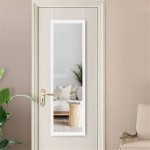Asian Three-Fold Mirror Reflections
The Asian three-fold mirror, also known as a triptych mirror, holds a significant place in various Asian cultures, including Chinese, Japanese, and Korean traditions. Beyond its practical use for applying makeup and styling hair, this object carries symbolic weight connected to beauty ideals, self-reflection, and even spiritual beliefs. This article will explore the historical context, cultural significance, and evolving interpretations of the three-fold mirror in Asian cultures.
Origins and Early Uses
The exact origin of the three-fold mirror is difficult to pinpoint, but archaeological evidence suggests early forms existed in ancient China during the Han Dynasty (206 BCE – 220 CE). These early mirrors were often made of bronze and highly polished to create a reflective surface. While not exclusively three-paneled, hinged mirrors became increasingly popular due to their portability and the ability to view oneself from multiple angles.
The Significance of the Three Panels
The three panels of the mirror aren't simply a matter of practicality. They have been imbued with symbolic meaning in various Asian cultures. * The central panel typically provides a direct, frontal reflection. * The side panels, angled inwards, offer views of the profile and back of the head, allowing for a more complete self-assessment. * This comprehensive perspective was seen as promoting self-awareness and encouraging meticulous grooming, aligning with cultural emphasis on outward appearance as a reflection of inner character and social standing. * In some interpretations, the three panels are linked to the philosophical concept of the three planes of existence: the physical, the mental, and the spiritual. * The act of looking into the mirror is therefore not just about checking one's appearance, but also engaging in a form of self-reflection that encompasses these three dimensions.
Cultural Variations and Symbolism
While the basic form remains consistent, the symbolism and usage of the three-fold mirror vary across different Asian cultures. * In China, the three-fold mirror was often associated with women and their beauty rituals. Elaborately decorated mirrors became prized possessions and were sometimes included in dowry chests, symbolizing a woman's transition into marriage and her role in maintaining beauty and harmony within the household. * Japanese culture also embraced the three-fold mirror, known as a *sankyō*, integrating it into traditional dress and theatrical performances. Its presence in Kabuki and Noh theater often serves to highlight specific emotions or character transformations. * Korean traditions link the three-fold mirror to specific rituals and ceremonies, sometimes used in shamanistic practices and for divination. The mirror's reflective surface was believed to hold a connection to the spiritual realm, allowing for glimpses into the future or communication with ancestors.
Materials and Artistry
The craftsmanship of Asian three-fold mirrors often showcases the artistic skills of the period and culture. * Materials used range from basic bronze and polished metal to intricate lacquer work, inlaid with precious stones, mother-of-pearl, or carved ivory. * Decorative motifs frequently featured auspicious symbols, such as dragons, phoenixes, flowers, and scenes from nature or mythology. * These embellishments elevated the mirror from a mere utilitarian object to a work of art, reflecting the cultural values and aesthetic sensibilities of its time.
Modern Interpretations and Continued Relevance
The three-fold mirror continues to be a popular item in modern Asia, retaining its practical function while also carrying a sense of cultural heritage. * Contemporary designs often incorporate modern materials and minimalist aesthetics, adapting the traditional form for contemporary tastes. * The symbolism associated with self-reflection and personal grooming remains relevant in modern society, where the mirror serves as a tool for self-presentation and cultivating one's image. * Artists and designers also continue to explore the symbolic potential of the three-fold mirror, incorporating it into their work to express ideas about identity, perception, and the multifaceted nature of the self.
Three-Fold Mirrors in Literature and Art
The three-fold mirror has also found its way into various forms of artistic expression. * Literature often uses the mirror as a metaphor for introspection and self-discovery, with characters confronting their inner selves through the mirror's reflections. * Visual arts frequently depict the three-fold mirror in portraits and genre scenes, highlighting its role in beauty rituals and social customs. * In some instances, the mirror becomes a symbolic portal to other realms or a representation of the subconscious mind, enriching the narrative and visual language of the artwork.
Collecting and Appreciating Antique Three-Fold Mirrors
Antique three-fold mirrors have become sought-after collectibles, offering glimpses into the artistry and cultural values of past eras. * Identifying authentic antique mirrors requires careful examination of materials, craftsmanship, and decorative motifs. * Understanding the historical context and regional variations helps in appreciating the unique characteristics of different styles and periods. * Preserving and displaying antique three-fold mirrors allows for the continued appreciation of these historical objects and the cultural narratives they embody.
The Three-Fold Mirror: A Timeless Reflection
From its practical origins to its rich symbolic associations, the three-fold mirror has held a lasting presence in Asian cultures. Its enduring appeal lies not only in its utility but also in its capacity to reflect cultural values, aesthetic ideals, and the ongoing human quest for self-understanding.

Asian Three Fold Mirror Projects Japan Foundation Wa Project

Asian Three Fold Mirror Projects Japan Foundation Wa Project

29th Tokyo International Festival The Asian Omnibus Series Three Fold Mirror 2024 Reflections

Omnibus Series Asian Three Fold Mirror 2024 Reflections Is Available For Free Streaming Until June 30 Jst News Japan Foundation Wa Project

Review Asian Three Fold Mirror Reflections 2024 By Brillante Ma Mendoza Isao Yisada And Sotho Kulikar

Asian Three Fold Mirror 2024 Reflections Mubi

Asian Three Fold Mirror 2024 Reflections Available For Free Streaming Brillante Ma Mendoza To Participate In The International Conference On Future Of Asia News Japan Foundation Wa Project

Asian Three Fold Mirror Projects Japan Foundation Wa Project

Asian Three Fold Mirror 2024 Reflections Malaysian Premiere Gsc Mid Valley

Asian Three Fold Mirror 2024 Reflections Trailer English Ver








